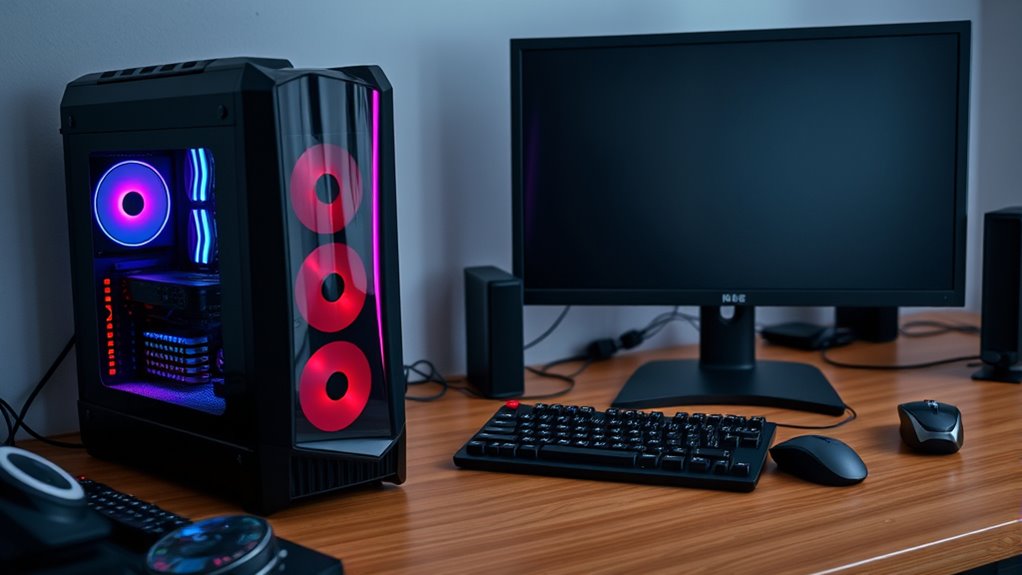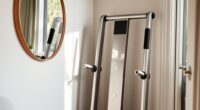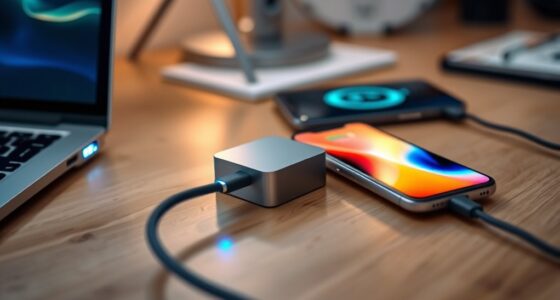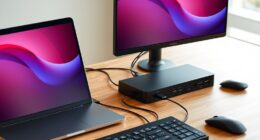To quiet a noisy desktop PC, start by cleaning your fans and heatsinks with compressed air to remove dust that causes higher fan speeds. Consider replacing loud fans with quieter, high-quality models, and adjust fan curves in BIOS for lower speeds. Upgrading your mechanical hard drive to an SSD reduces whine, and adding vibration-dampening mounts can help minimize noise. Ensuring proper airflow and cooling will keep components cooler, lowering noise overall—continue exploring these tips to create a quieter setup.
Key Takeaways
- Clean dust from fans and heatsinks to improve airflow and reduce fan noise.
- Replace loud fans with quieter models featuring fluid-dynamic bearings or larger blades.
- Upgrade mechanical hard drives to SSDs to eliminate hard drive whine.
- Optimize case airflow with additional or sound-dampening case fans to lower component temperatures.
- Use rubber mounts or foam pads to reduce vibrations and noise from hard drives.

If your desktop PC is making more noise than you’d like, it’s time to take action. The constant hum of fan noise or that high-pitched hard drive whine can be distracting and even signal underlying issues. Fortunately, you can quiet your setup without replacing entire components. Start by identifying the main sources of noise. Fans are often the culprits, especially if they’re running at high speeds to cool overheating components. Hard drive whine, on the other hand, is a common issue with mechanical drives, producing a high-pitched screech that can be quite annoying.
Identify and address fan noise and hard drive whine to create a quieter, more peaceful PC environment.
To reduce fan noise, first check if your fans are clogged with dust. Dust buildup hampers airflow and causes fans to work harder, increasing noise levels. Turn off your PC, open the case, and carefully clean the fans and heatsinks with compressed air. Make sure to hold the fan blades steady to prevent damage. If the fans are old or poorly designed, consider replacing them with quieter models. Look for fans with fluid-dynamic bearings or larger blades that spin at lower RPMs but still move sufficient air. You can also adjust the fan curve through your BIOS or fan control software, setting fans to operate at lower speeds during light tasks.
Hard drive whine is trickier since it’s often related to the drive’s internal mechanics. If your hard drive is making consistent high-pitched noises, consider replacing it with a solid-state drive (SSD). SSDs operate silently because they lack moving parts, drastically reducing overall noise. If switching isn’t an option right away, try to minimize vibrations by placing foam pads or rubber mounts between the drive and the case. Also, ensure your hard drive isn’t working excessively; run disk health checks and defragment your drive if needed. Sometimes, excessive activity can cause the whine to become more noticeable. Upgrading your hard drive to an SSD is the most effective long-term solution for eliminating hard drive whine altogether.
Finally, pay attention to airflow and case design. Proper ventilation reduces the need for fans to spin at high speeds. Adding case fans or upgrading to a case with sound-dampening panels can help. Keep your PC in a cool, well-ventilated area, and avoid placing it near heat sources. Regular maintenance, such as cleaning filters and checking for dust buildup, will keep your PC running smoothly and quietly. Additionally, choosing a high-quality projector with good cooling and low noise levels can contribute to a quieter overall setup. With these steps, you’ll notice a significant drop in fan noise and hard drive whine, making your computing experience more peaceful and enjoyable.
Frequently Asked Questions
Which Components Are the Loudest in a Desktop PC?
The loudest components in your desktop PC are usually the hard drive and the power supply. Hard drives can produce noticeable noise when spinning or seeking data, while the power supply often emits a hum or whine under load. You can reduce these sounds by upgrading to quieter models, adding sound dampening materials, or ensuring proper airflow. These steps help keep your PC running quietly and smoothly.
Can Software Adjustments Reduce Hardware Noise?
Think of your PC as a symphony, where software tweaks can help tame the noise. By adjusting fan speed control settings, you can turn down the volume, making the hum less of a disturbance. While software adjustments won’t silence every mechanical component, they can considerably reduce whirring sounds and improve your overall experience, allowing your computer to perform quietly without sacrificing performance.
What Are the Best Quiet Cooling Solutions?
The best quiet cooling solutions include liquid cooling systems and soundproof cases. Liquid cooling reduces noise by efficiently dissipating heat with fewer fans, making your PC much quieter. Soundproof cases further dampen noise, preventing vibrations and airflow sounds from reaching you. Combining these options ensures a considerably quieter desktop, so you can enjoy your work or gaming sessions without distractions. Choose high-quality liquid coolers and soundproof cases for peak silence.
How Does Case Design Influence Noise Levels?
Imagine a fortress, where soundproofing materials and airflow optimization work together to keep noise at bay. Your case design influences noise levels by incorporating soundproofing panels that absorb vibrations and dampen sound. Optimized airflow reduces the need for loud fans, ensuring quieter operation. A well-designed case balances these elements, minimizing noise without sacrificing cooling performance, creating a peaceful environment for your work or gaming sessions.
Are Silent PC Components Cost-Effective?
Silent PC components can be cost-effective if you value a quieter workspace. Investing in silent fans and adding acoustic panels help reduce noise without needing expensive modifications. While the initial cost might be higher, you save on energy and potential hardware wear caused by loud operation. Overall, these components improve your PC experience and can be a smart investment, especially if you work or game in noise-sensitive environments.
Conclusion
By taking these simple steps, you can silence that noisy desktop and enjoy a peaceful workspace. Remember, a quiet PC isn’t out of reach—you just need to tackle the problem head-on. Don’t let the noise get under your skin; instead, address it before it becomes a bigger headache. With a little effort, you’ll have your computer running smoothly and quietly, proving that sometimes, a little elbow grease can turn the tide in your favor.









